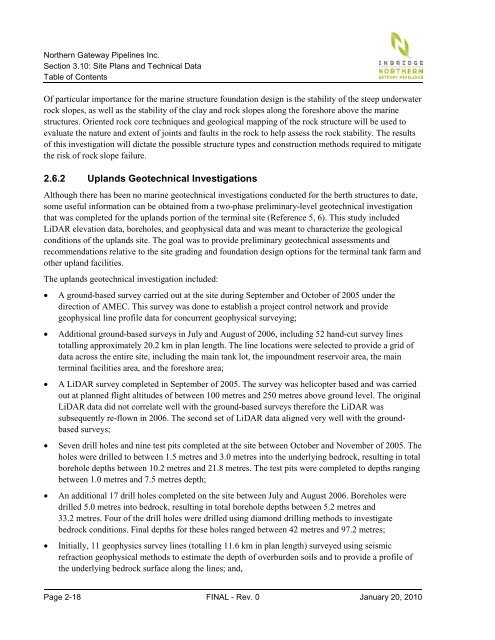Section 3.10: Site Plans and Technical Data - Rick Neufeld Comments
Section 3.10: Site Plans and Technical Data - Rick Neufeld Comments
Section 3.10: Site Plans and Technical Data - Rick Neufeld Comments
Create successful ePaper yourself
Turn your PDF publications into a flip-book with our unique Google optimized e-Paper software.
Northern Gateway Pipelines Inc.<br />
<strong>Section</strong> <strong>3.10</strong>: <strong>Site</strong> <strong>Plans</strong> <strong>and</strong> <strong>Technical</strong> <strong>Data</strong><br />
Table of Contents<br />
Of particular importance for the marine structure foundation design is the stability of the steep underwater<br />
rock slopes, as well as the stability of the clay <strong>and</strong> rock slopes along the foreshore above the marine<br />
structures. Oriented rock core techniques <strong>and</strong> geological mapping of the rock structure will be used to<br />
evaluate the nature <strong>and</strong> extent of joints <strong>and</strong> faults in the rock to help assess the rock stability. The results<br />
of this investigation will dictate the possible structure types <strong>and</strong> construction methods required to mitigate<br />
the risk of rock slope failure.<br />
2.6.2 Upl<strong>and</strong>s Geotechnical Investigations<br />
Although there has been no marine geotechnical investigations conducted for the berth structures to date,<br />
some useful information can be obtained from a two-phase preliminary-level geotechnical investigation<br />
that was completed for the upl<strong>and</strong>s portion of the terminal site (Reference 5, 6). This study included<br />
LiDAR elevation data, boreholes, <strong>and</strong> geophysical data <strong>and</strong> was meant to characterize the geological<br />
conditions of the upl<strong>and</strong>s site. The goal was to provide preliminary geotechnical assessments <strong>and</strong><br />
recommendations relative to the site grading <strong>and</strong> foundation design options for the terminal tank farm <strong>and</strong><br />
other upl<strong>and</strong> facilities.<br />
The upl<strong>and</strong>s geotechnical investigation included:<br />
• A ground-based survey carried out at the site during September <strong>and</strong> October of 2005 under the<br />
direction of AMEC. This survey was done to establish a project control network <strong>and</strong> provide<br />
geophysical line profile data for concurrent geophysical surveying;<br />
• Additional ground-based surveys in July <strong>and</strong> August of 2006, including 52 h<strong>and</strong>-cut survey lines<br />
totalling approximately 20.2 km in plan length. The line locations were selected to provide a grid of<br />
data across the entire site, including the main tank lot, the impoundment reservoir area, the main<br />
terminal facilities area, <strong>and</strong> the foreshore area;<br />
• A LiDAR survey completed in September of 2005. The survey was helicopter based <strong>and</strong> was carried<br />
out at planned flight altitudes of between 100 metres <strong>and</strong> 250 metres above ground level. The original<br />
LiDAR data did not correlate well with the ground-based surveys therefore the LiDAR was<br />
subsequently re-flown in 2006. The second set of LiDAR data aligned very well with the groundbased<br />
surveys;<br />
• Seven drill holes <strong>and</strong> nine test pits completed at the site between October <strong>and</strong> November of 2005. The<br />
holes were drilled to between 1.5 metres <strong>and</strong> 3.0 metres into the underlying bedrock, resulting in total<br />
borehole depths between 10.2 metres <strong>and</strong> 21.8 metres. The test pits were completed to depths ranging<br />
between 1.0 metres <strong>and</strong> 7.5 metres depth;<br />
• An additional 17 drill holes completed on the site between July <strong>and</strong> August 2006. Boreholes were<br />
drilled 5.0 metres into bedrock, resulting in total borehole depths between 5.2 metres <strong>and</strong><br />
33.2 metres. Four of the drill holes were drilled using diamond drilling methods to investigate<br />
bedrock conditions. Final depths for these holes ranged between 42 metres <strong>and</strong> 97.2 metres;<br />
• Initially, 11 geophysics survey lines (totalling 11.6 km in plan length) surveyed using seismic<br />
refraction geophysical methods to estimate the depth of overburden soils <strong>and</strong> to provide a profile of<br />
the underlying bedrock surface along the lines; <strong>and</strong>,<br />
Page 2-18 FINAL - Rev. 0 January 20, 2010
















